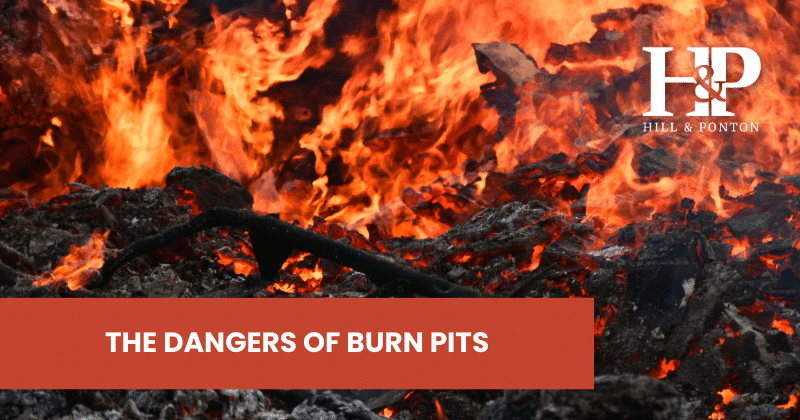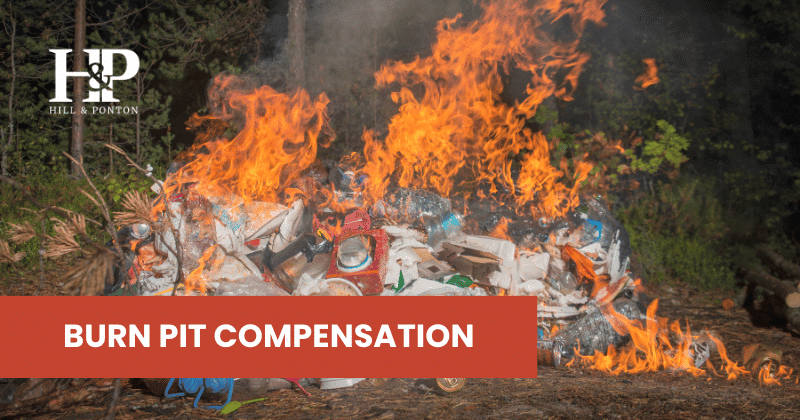The PACT Act was signed into law by President Biden on August 8, 2022, but active duty service members in Afghanistan, Syria, and Egypt are still being exposed to burn pits. US Central Command apparently cannot find a good alternative and still has nine operational pits and plans to continue to use them.
The VA has long contended there is no pollution caused by burn pit exposure that causes long-term health care problems. However, particulates measured by the Department of Defense from the pits as far back as 2011 contained polychlorinated dibenzofurans, polycyclic aromatic hydrocarbons, Volatile Organic Compounds, and polychlorinated dibenzo-p-dioxins (PCDDs).
In November 2009, the Institute of Medicine in conjunction with the Department of Veterans Affairs conducted a study of burn pits and revealed that 2,3,7,8-TCDD, the dioxin found in Agent Orange, was found in the air surrounding burn pits in Iraq and Afghanistan[1]. Therefore, post-9/11 claims for burn pits health conditions that are presumptive to herbicide exposure, are also entitled to presumption under VA CFR § 3.307(a)(6).
Health Care and Open Burn Pit Registry
In 2014, the VA Burn Pit Registry was established. Over 200,000 veterans have already registered with the VA’s Burn Pit Registry and filled out the registry questionnaire. Registration helps to show patterns of illnesses that spur future research studies for links to exposure and all information is kept in a secure database. The more veterans who register that have similar conditions, the more chances of linking the illness and pursuing presumption for veterans. The registration is now available via Telehealth depending on location.
Veterans eligible for burn pit exposure include those who served during the following campaigns:
- Southwest Asia Theater of operations on or after August 2, 1990
- Operation Desert Storm or Operation Desert Shield
- Djibouti, Africa on or after September 11, 2001
- Operation Enduring Freedom/Operation Iraqi Freedom/Operation New Dawn
The registry will make it easier to study the long-term health effects of those exposed to burn pit particulates as well as other environmental exposures during the Middle Eastern campaigns and within these theaters of operations.

Veterans Burn Pits Exposure Recognition Act
In November 2019, the Senate introduced the Veterans Burn Pits Exposure Recognition Act to bipartisan favor. The Act provides for the VA to concede burn pit exposure to military service members exposed from as far back as 1990 to include those who served in the first Gulf War, after 9/11 in Afghanistan, Iraq, and the Southwest Asia Theater of operations, and those who served in military sites near burn pits per the definitions outlined in the bill.
If a veteran was not close to a burn pit but experienced toxic exposure due to heavy winds, cross-contamination from transfers of items/food from other areas, or toxins that contaminated groundwater, the burden of proof will be, once again, on the veteran despite the old adage of the VA being on the veteran’s side.
Airborne Hazards
Burn pits expose veterans to airborne hazards called “particulates” which are small particles of residue from the debris in the burn pits that are inhaled by those in the area of the smoke plume. These particulates settle in the lungs and can cause a myriad of health problems based on what the particulate is composed of or has transformed into due to incineration.
For example, burning Styrofoam can cause a chemical reaction that releases the dioxin TCDD, the chemical in Agent Orange. Not only can these particulates cause respiratory and lung issues; but the chemicals they become when they are burned can also cause illnesses within the rest of the body that may not show up for years.
Burn Pit Dangers
Burn pits were originally a temporary solution in U.S. military base camps to the build-up of refuse and waste until incinerators and other permanent solutions were built. During the past three decades of fighting in Iraq and Afghanistan, burn pits that started off small, sometimes in refuse bins, have grown as large as 25+ acres.
There are no restrictions on what is put in a burn pit. Where most of the world has restrictions on what can be burned in open areas to prevent populations from exposure to toxic plumes of smoke, this is not the case in the war-torn Middle East. Most of these pits are used for everything from electronics, engines, munitions, fuels, cleaning agents, paints, tires, human waste, food waste, medicines, regular trash, and bio- or everyday chemicals that, when heated, create toxic fumes.
PACT Act recognizes the following illnesses and conditions as being linked to burn pit toxic exposure
- Brain cancer
- Gastrointestinal cancer of any type
- Glioblastoma
- Head cancer of any type
- Kidney cancer
- Lymphatic cancer of any type
- Lymphoma of any type
- Melanoma
- Neck cancer
- Pancreatic cancer
- Reproductive cancer of any type
- Respiratory (breathing-related) cancer of any type
- Asthma that was diagnosed after service
- Chronic bronchitis
- Chronic obstructive pulmonary disease (COPD)
- Chronic rhinitis
- Chronic sinusitis
- Constrictive bronchiolitis or obliterative bronchiolitis
- Emphysema
- Granulomatous disease
- Interstitial lung disease (ILD)
- Pleuritis
- Pulmonary fibrosis
- Sarcoidosis
If a veteran has service-related health concerns, they can have an optional medical evaluation done at the VA, but getting an independent medical opinion is vital to proactively identify health concerns and having an expert find scientific links for those conditions to the toxins that the veteran was exposed to. Please call Hill and Ponton for more information or for a free consultation of your claim.
[1] Institute Of Medicine, U. S. C. O. T. L. H. C. O. E. T. B. P. I. I. A. A. (2011) Long-term health consequences of exposure to burn pits in Iraq and Afghanistan. Washington, D.C.: National Academies Press. [Web.] Retrieved from the Library of Congress, https://lccn.loc.gov/2012392162.




